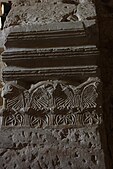Santa María (Wamba)
The church of Santa María in the municipality of Wamba is located 17 km west of Valladolid in the province of the same name in the autonomous Spanish region of Castile and León . Its pre-Romanesque choir head with three apses from the 10th century - like the church in San Cebrián de Mazote , a few kilometers away - is attributed to Mozarabic architecture. The nave of the church is Romanesque and dates from the end of the 12th century.
history
The first monastery is said to have been founded in Wamba as early as 670 at the suggestion of the Visigoth king Rekkeswinth . In 672 King Rekkeswinth died in a Marian monastery in Gérticos , where his successor Wamba was appointed. The place Gérticos is said to have been renamed Wamba afterwards, but this is not documented. Archaeological excavations in 1988 uncovered remains of the foundations of a previous building from Roman to Visigothic times. The history of the monastery from the time of the Moorish conquest to the reconquest under Alfons III. (866–910) is in the dark. For the year 928 an abbot named Frunimius is mentioned in contemporary chronicles , who is also referred to as bishop . Presumably this refers to the Bishop of León , who gave up his office in 928. The construction of the church is dated to this time. In the 12th century, the monastery passed to the Order of St. John , who owned it until the 19th century. The present nave was built at the end of the 12th century. The monastery buildings, which are largely in ruins today, were added later.
architecture
From the pre-Romanesque building of the 10th century, the north wall of the nave, the transept and the choir with three square apses are still preserved. The ground plan of the church is a rectangle from which the main apse protrudes to the east. The 10th century walls are characterized by the use of quarry stone with mortar . The arches of the crossing have a horseshoe shape and are supported by mighty pillars with pilasters . These are three-step, sharp fluted fighters and provided with capitals whose decor is made of flowers and leaves in precise kerf. Even if the capitals of Wamba were made in the much softer limestone , they are so similar to the marble capitals of San Miguel de Escalada that one assumes the same stonemasons .
The Roman nave has three vessels , of ogival arcade on rectangular columns are columns with templates separated. The pillars and half-columns are decorated with capitals on which stylized leaves and figural scenes are depicted, such as the weighing of souls of St. Michael or the patron saint of shoemakers, St. Crispinus biting into a piece of leather.
portal
On the west facade there is a Romanesque portal , the three archivolts of which rest on three columns each . The tympanum, decorated only with carved rosettes , rests on corbels ( mochetas ) in the form of human heads. The Portal Zone crowned a narrow, with a role Fries provided canopy on corbels, which are shaped as animals or heads of humans and animals.
Wall painting
On the front wall of the apse there is a wall painting in black and brick-red colors on a white background. A Greek cross is shown in the middle , next to it eight squares with circles inscribed. Stylized animals that are interpreted as lions are depicted in two circles. It is controversial whether this is an - extremely rare - Mozarabic painting or whether it comes from the Romanesque period.
Furnishing
- In the church there is a Byzantine capital from the 5th century, decorated with foliage , which has been converted into a holy water font.
- Embedded in a wall of the northern apsidiole is a stone slab with the relief of an isosceles cross , the arms of anchor-shaped end.
literature
- Achim Arbeiter , Sabine Noack-Haley: Christian monuments of the early Middle Ages from the 8th to the 11th century . Mainz 1999, ISBN 3-8053-2312-3 , pp. 285-290.
- Jaime Cobreros: Guía del Prerrománico en España . Madrid 2006, ISBN 84-9776-215-0 , pp. 172-173.
- Jacques Fontaine: L'Art Mozarabe. L'Art Préroman Hispanique . Vol. 2, 2nd edition, Éditions Zodiaque, Abbaye de la Pierre-Qui-Vire 1995, ISBN 2-7369-0215-7 , pp. 204-208.
- Javier Sainz Saiz: El Arte Prerrománico en Castilla y León . Ediciones Lancia, León 2006, ISBN 84-8177-029-9 , pp. 87-90.
Web links
Coordinates: 41 ° 40 ′ 34.4 " N , 4 ° 55 ′ 4" W.










